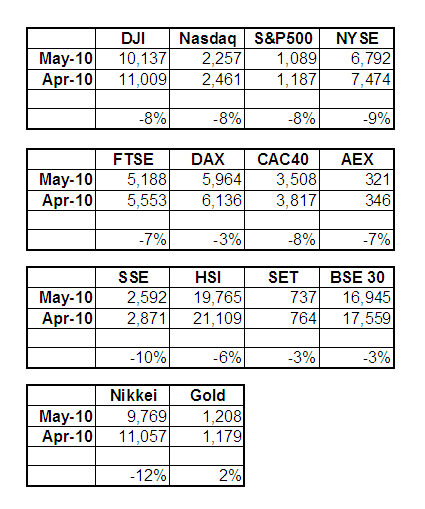timing
Which stock market indices declined most during May?
Submitted by Van Beek on June 1, 2010 - 08:45How much did the different stock market indices actually decline during May? And which markets declined more, the US markets, the Asian markets or the European markets?
At Stock Trend Investing, we made a quick overview for you to get an answer to these questions. Some of the observations are surprising.

What is the best week of the month to trade index funds
Submitted by Van Beek on March 23, 2010 - 04:05Does it make a difference during which week of the month you buy or sell your index funds? At Stock Trend Investing we dived into the data and present you here with our conclusions.
We haven’t just looked at every month during the last 13 years. We have also looked specifically at the months that follow directly an “Up” or “Down” trend expectation from Stock Trend Investing. The results are different for each of the considered cases.

Stock Market Trend Analysis
Submitted by Van Beek on March 19, 2010 - 17:34Stock Trend Investing is specialized in Stock Market Trend Analysis. Every month we analyse and review the trends in a number of major stock market indices. Yes, we review it every month, not every day. The reason for that is that the typical user of the Stock Trend Investing system does not have time to trade every day. Our users only want to spend maximum one hour per month on their investments.
Therefore, Stock Trend Investing is performing a specific monthly stock market trend analysis. If the user of the analysis only wants to trade once per month, the analysis has to be targeted to that. Likewise, a trend investor who wants to trade every day needs a daily stock market trend analysis.
Market Timing Mutual Funds
Submitted by Van Beek on March 16, 2010 - 10:08Market timing for mutual funds is crucial for being successful with investing in mutual funds. Stock Trend Investing is focused on giving market timing signals for investors in mutual funds and index funds.
Different market timing systems have different timing horizons. Some look at the timing within a few hours, others look at the market timing within a few days or weeks. Stock Trend Investing considers the longer term trends that are expected to last a few months or even a few years.
Members of the Stock Trend Investing community review their positions only once per month. This is especially suitable for people who cannot or do not want to spend every day or week a certain amount of time on their investments.
The secret of stock market timing
Submitted by Van Beek on November 8, 2009 - 03:39 However, take into account that the Dow Jones index closing for October 2009 is 30% lower than its highest all-time month closing of October 2007, 2 years ago, while still being up more than 37% compared to February 2009, 8 months ago. And consider that the Dow Jones index fell 34% between December 1999 and September 2002, while it increased again 83% between September 2002 and October 2007.
However, take into account that the Dow Jones index closing for October 2009 is 30% lower than its highest all-time month closing of October 2007, 2 years ago, while still being up more than 37% compared to February 2009, 8 months ago. And consider that the Dow Jones index fell 34% between December 1999 and September 2002, while it increased again 83% between September 2002 and October 2007.Who else wants to ride stock market trends to create a fortune?
Submitted by Van Beek on November 3, 2009 - 16:12
8 ways to spread the risk in your stock market investment
Submitted by Van Beek on October 27, 2009 - 09:32 In the beginning of 2000, I did not have my system yet for recognizing market trends and when to make or when to get rid of your stock market investments. During the boom years before I was always afraid that I was too late to step in since the markets had gone up so far already. And every month I was proven wrong since the markets went up further.
In the beginning of 2000, I did not have my system yet for recognizing market trends and when to make or when to get rid of your stock market investments. During the boom years before I was always afraid that I was too late to step in since the markets had gone up so far already. And every month I was proven wrong since the markets went up further.- Stretch your new investments in the stock market out in time, over a number of months.
- Split the investments that you plan to make during a month in two or more batches and execute these trades at different dates during the month.
- Spread out the selling of your stock market investments over a certain time period. Note that in general I prefer to get “out” more quickly than that I get “in”.
- Diversify your investments over different continents.
- Spread your investments over companies with different sizes.
- When investing in markets abroad, consider how the currencies from those markets might move in strength versus your home currency.
- Spread your stock market investment over different industry sectors.
- Divide your investments over different companies to be less dependent on the performance of one particular company.


